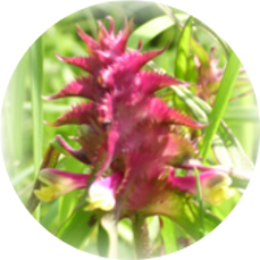Special Roadside Verges
Some of the last wildflower rich grassland in the district survives on a number of roadside verges, designated as Special Roadside Verges, which are marked with posts that carry this sign.
These verges have until recently been managed by a partnership project made up of Essex County Council, whose Highways service carries out the cutting of the verges at the right times of the year, and Essex Wildlife Trust and its volunteers, who surveyed the verges each year to check the species that are growing there, and in Uttlesford Saffron Walden Museum, whose Natural Sciences Officer co-ordinated the management and surveys, and compiled reports on the condition of these verges.
Unfortunately in 2024 Essex Wildlife Trust has had to withdraw from the surveying of the verges due to the inability to get insurance cover for volunteers to work on highway verges because of the perceived risk. Staff reductions at Uttlesford District Council funded Saffron Walden Museum have meant the retirement of the officer who co-ordinated the project there, and cessation of their involvement.
It is to be hoped that the County Council will continue with the project to keep these verges in good condition.
Be safe when visiting the special roadside verges!
• Safety is paramount for pedestrians and road users at all times. These roads can be busy and dangerous!
• If visiting a site alone, tell someone where you are going, and when you intend to return.
• If you use a car, park it safely, so it does not create a hazard near to a corner and does not block a working entrance. If possible park off road in a lay-by. For obvious reasons, please do not park on the special verge!
• Walk on the pavement, or the verge itself if there is no pavement. Do not walk along the road surface.
• Face the traffic when walking along the verge so you can keep an eye out for hazards.
Some suggested verges to visit
The following verges are attractive in early to middle summer and the roads are relatively quiet. If you go by car please park carefully and for obvious reasons please do not park on the verge. Keep an eye out for passing traffic.
∗ Strethall Road, Littlebury (east of the motorway) – Grid References TL503398 to TL512398 – good chalk flora with Bee Orchid.
∗ Wicken Bonhunt at the east end of the village on the double bend – Grid referencesTL502334 to TL504337 – good chalk to neutral soil flora. Park at the top of the hill in the lay-by on the bend.
∗ Langley Upper Green close to High Wood on the road to Duddenhoe End – Grid References TL450356 to TL 454358 on both sides of the road.
Park in the lay-by on the bend outside High Wood. [NB There is no public access to this wood]. These verges are the largest known colony of Crested Cow-wheat (the logo of this website) in both Uttlesford, Essex and the United Kingdom.
∗ Audley End Park Wall, TL524380 to TL532378 between the Lion Gate entrance to the House, and the top of the hill. A site for the rare Lesser Calamint and Pellitory-of-the-wall. Though the verge does suffer from invading Nettles and is not a “picture postcard” wildflower verge, shouldn’t rare things be protected even if they are plain? This makes a good walk from Saffron Walden but if you do drive there please park at Audley End village half-way along the verge.
∗ Near Hatfield Broad Oak – the lane running east to west, to the south of Little Barrington Hall, TL542188 to TL544188. A good range of species including the rare Sulphur Clover, Grass Vetchling and Yellowwort. There is a lay-by for parking at the east end.
∗ Little Chesterford Roundabout TL 519418 – the area of the former road south of the crossroads junction at the east end of the village. This area was cut off when the roundabout was constructed, and because the new roundabout destroyed part of an existing special verge, topsoil from that lost area was spread on the old abandoned road area. This is now a meadow, and is showing a surprisingly good range of species, including the rare Wild Liquorice, and other chalk loving species. A good example of a successful habitat creation scheme. Park on the now truncated old road.
Set yourself a challenge and see how many species you can find.
More information about the special verges can be seen on this webpage from Uttlesford District Council – Special Roadside Verges.
Verges Cycle Rides
Three suggested cycle rides which pass by a selection of the special verges. These routes are on public highways, so be watchful of traffic at all times. A page of information for each ride can be accessed by clicking the bicycle sign under each ride description.
Ride 1; An 18 mile cycle ride starting and finishing at Saffron Walden has been devised to visit a selection of the special verges in this area, featuring chalk grassland species, and some real rarities. The route details can be downloaded by clicking the bicycle sign beneath.
Ride 2; A 12 to 13 mile route starting and finishing at Arkesden, taking in four special verges including the best colony of Crested Cow-wheat in the UK.
Ride 3; A 12 to 13 mile route starting and finishing at Great Dunmow, taking in part of the Flitch Way


